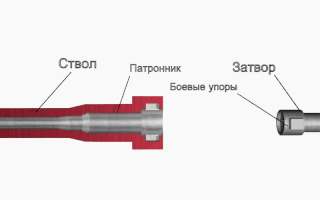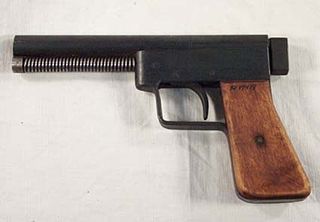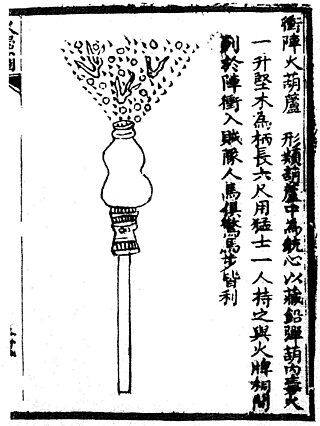
A marble gun is a type of an improvised caseless firearm or zip gun that shoots marbles, through gas pressure from the ignition of denatured alcohol. They are mainly used to shoot birds or for home defense use.

A marble gun is a type of an improvised caseless firearm or zip gun that shoots marbles, through gas pressure from the ignition of denatured alcohol. They are mainly used to shoot birds or for home defense use.
A marble gun has four major components: a barrel, a chamber, an ignition source, and a stock.
Barrels are mostly made with PVC pipes or scrap metal tubing which makes it a smoothbore firearm , sometimes even repurposed rifle barrels. Chambers are usually made from recycled PET or other similar plastic containers, albeit, resistant enough from extreme heat. A common ignition source used is the piezo ignition component found in lighters. Stocks are usually made from planks or carved wood, and there are some instances where an actual rifle stock is used.
As it is an improvised weapon, it is commonly combined together using hot glue, electrical tapes, duct tapes or any combination of those adhesives.
Generally speaking, a marble gun is operated similarly to modern bamboo cannons, where the user sprays denatured alcohol first on the chamber, distribute inside by shaking it, and then inserting one or few marbles in the barrel, and produce a spark by using the piezo ignition component.
There are several reported cases of injuries and deaths caused by marble guns:

A firearm is any type of gun that uses an explosive charge and is designed to be readily carried and used by an individual. The term is legally defined further in different countries.

A rifle is a long-barreled firearm designed for accurate shooting and higher stopping power, with a barrel that has a helical pattern of grooves (rifling) cut into the bore wall. In keeping with their focus on accuracy, rifles are typically designed to be held with both hands and braced firmly against the shooter's shoulder via a buttstock for stability during shooting. Rifles are used extensively in warfare, law enforcement, hunting and target shooting sports.

A gun barrel is a crucial part of gun-type weapons such as small firearms, artillery pieces, and air guns. It is the straight shooting tube, usually made of rigid high-strength metal, through which a contained rapid expansion of high-pressure gas(es) is used to propel a projectile out of the front end (muzzle) at a high velocity. The hollow interior of the barrel is called the bore, and the diameter of the bore is called its caliber, usually measured in inches or millimetres.

An automatic firearm or fully automatic firearm is an autoloading firearm that continuously chambers and fires rounds when the trigger mechanism is actuated. The action of an automatic firearm is capable of harvesting the excess energy released from a previous discharge to feed a new ammunition round into the chamber, and then igniting the propellant and discharging the projectile by delivering a hammer or striker impact on the primer.
A pneumatic weapon is a weapon that fires a projectile by means of air pressure, similar in principle to the operation of pneumatic tube delivery systems. The term comes from a Greek word for "wind" or "breath" (πνεῦμα).
Blowback is a system of operation for self-loading firearms that obtains energy from the motion of the cartridge case as it is pushed to the rear by expanding gas created by the ignition of the propellant charge.

The lock of a firearm is the mechanism used to initiate firing. It is a historical term, in that it generally refers to such mechanisms used in muzzle-loading and early breech-loading firearms. Side-lock refers to the type of construction, in which the individual components of the mechanism are mounted either side of a single plate. The assembly is then mounted to the stock on the side of the firearm. In modern firearm designs, the mechanism to initiate firing is generally constructed within the frame or receiver of the firearm and is referred to as the firing or trigger mechanism.
A gunstock or often simply stock, the back portion of which is also known as a shoulder stock, a buttstock, or simply a butt, is a part of a long gun that provides structural support, to which the barrel, action, and firing mechanism are attached. The stock also provides a means for the shooter to firmly brace the gun and easily aim with stability by being held against the user's shoulder when shooting the gun, and helps to counter muzzle rise by transmitting recoil straight into the shooter's body.
Thompson/Center Arms was an American firearms company based in Springfield, Massachusetts. The company was best known for its line of interchangeable-barrel, single-shot pistols and rifles. Thompson/Center also manufactured muzzle-loading rifles and was credited with creating the resurgence of their use in the 1970s.

A slamfire is a discharge of a firearm occurring as a cartridge is being loaded into the chamber. Some firearms are designed to slamfire, but the term also describes a malfunction of self-loading firearms. Shooters accustomed to firearms requiring trigger activation for discharge may be unprepared for a slamfire discharge.

A bamboo cannon is a type of home-made firecracker which is popular during the Eid season in Malaysia and Indonesia, as well as during New Year's Eve celebrations in the Philippines.

Improvised firearms are firearms manufactured other than by a firearms manufacturer or a gunsmith, and are typically constructed by adapting existing materials to the purpose. They range in quality from crude weapons that are as much a danger to the user as the target to high-quality arms produced by cottage industries using salvaged and repurposed materials.

An antique firearm is a term used to describe a firearm that was designed and manufactured prior to the beginning of the 20th century. Although the exact definition of what constitutes an "antique firearm" varies between countries, the advent of smokeless powder or the start of the Boer War are often used as cut-off dates. Antique firearms are usually collected because of their historical interest and/or their monetary value.

A handgun is a firearm designed to be usable with only one hand. It is distinguished from a long gun which needs to be held by both hands and braced against the shoulder. Handguns have shorter effective ranges compared to long guns, and are much harder to shoot accurately. While most early handguns are single-shot pistols, the two most common types of handguns used in modern times are revolvers and semi-automatic pistols, although other handguns such as derringers and machine pistols also see infrequent usage.

The history of firearms begins in 10th-century China, when tubes containing gunpowder and pellet projectiles were mounted on spears to make portable fire lances, operable by one person. This was later used effectively as a shock weapon in the Siege of De'an in 1132. In the 13th century, fire lance barrels were replaced with metal tubes and transformed into metal-barreled hand cannons. The technology gradually spread throughout Eurasia during the 14th century and evolved into flintlocks, blunderbusses, and other variants. The 19th and 20th centuries saw an acceleration in this evolution, with the introduction of the magazine, belt-fed weapons, metal cartridges, and the automatic firearm. Older firearms typically used black powder as a propellant, but modern firearms use smokeless powder or other propellants. Most modern firearms have rifled barrels.
The following are terms related to firearms and ammunition topics.

Title II weapons, or NFA firearms, are designations of certain weapons under the United States National Firearms Act (NFA).

A gun is a device designed to propel a projectile using pressure or explosive force. The projectiles are typically solid, but can also be pressurized liquid, or gas. Solid projectiles may be free-flying or tethered. A large-caliber gun is also called a cannon.

A multiple-barrel firearm is any type of firearm with more than one gun barrel, usually to increase the rate of fire or hit probability and to reduce barrel erosion or overheating.
In firearms,Tapering refers to components that narrow down, similar to that of a conical fashion hence the name taper.